#tyrannosaurini
Text
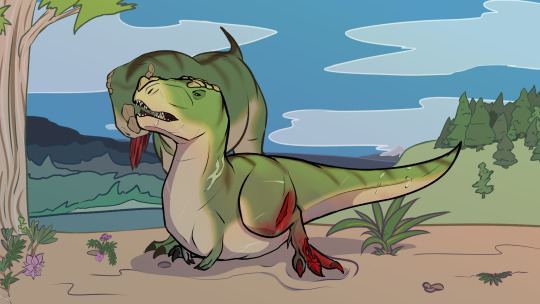
AWMM-IL 2022.21 “Barbara” is a Tyrannosaurus Rex skeleton unearthed from the Hell Creek formation in Montana, recently on display at New Zealand’s Auckland War Memorial Museum. She is best known for possibly being pregnant, assumed due to the presence of medullary bone tissue, and for a catastrophic metatarsal injury which would have rendered her unable to hunt while recovering and with a noticeable limp afterwards, but which was clearly healed. The implications of her survival through such an injury are fascinating, but any formal papers on Barbara will be long in coming as she has returned to her private owner since her exhibit closed at the end of 2023.
#paleoart#tyrannosaurus rex#tyrannosaurini#tyrannosauridae#tyrannosaurinae#therapoda#saurischia#dinosauria#chordata#animalia#eukaryota#Barbara rex
15 notes
·
View notes
Photo

Day 7: Zhuchengtyrannus A Chinese relative of Mongolian Tarbosaurus and even North American Tyrannosaurus. #Dinovember2022 #Dinovember #paleoart #artistsoninstagram #sketchbookapp #zhuchengtyrannus #tyrannosaurini #tyrannosaurine #tyrannosauridae #theropoda #dinosauria #dinosaur #myart https://www.instagram.com/p/CkrvP35LvHY/?igshid=NGJjMDIxMWI=
#dinovember2022#dinovember#paleoart#artistsoninstagram#sketchbookapp#zhuchengtyrannus#tyrannosaurini#tyrannosaurine#tyrannosauridae#theropoda#dinosauria#dinosaur#myart
2 notes
·
View notes
Text
A giant tyrannosaur from the Campanian–Maastrichtian of southern North America and the evolution of tyrannosaurid gigantism
Published 11th January 2024
Discovery of a new tyrannosaurin, Tyrannosaurus mcraeensis, based on a fossil from the Hall Lake Formation of New Mexico previously referred to as Tyrannosaurus rex. Tyrannosaurus mcraeensis predates Tyrannosaurus rex by ~ 6–7 million years, yet they were similar sizes, Phylogenetic analysis leads to Tyrannosaurus mcraeensis as sister to Tyrannosaurus rex and indicates that Tyrannosaurini originated within southern Laramidia.

Locality and stratigraphy of Tyrannosaurus mcraeensis, reconstruction of cranial elements and silhouette; Cranial elements of Tyrannosaurus mcraeensis holotype
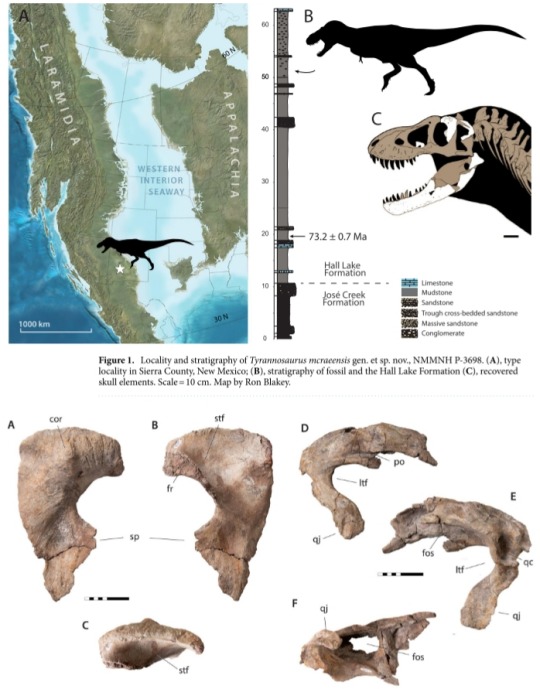
Mandibular elements of Tyrannosaurus mcraeensis holotype
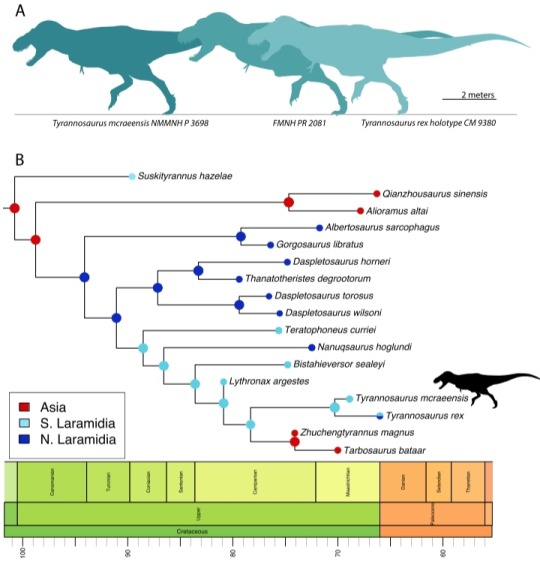
phylogenetic anaylsis of Tyrannosaurus mcraeensis
Source:
(I'm back from a break, enjoy reading this great publication! It took a few years to make so support the team who worked on this and click on the link if you're interested.)
#paleontology#fossil#prehistoric#extinct#science#dinosaur#dinosaurs#new species#tyrannosaurus rex#tyrannosaurid#t rex#Tyrannosaurus mcraeensis
20 notes
·
View notes
Text
A young T. rex being taught a lesson in humility by its desired meal.
Triceratops horridus
('three-horned face, rough/rugose')
Chasmosaurinae Triceratopsini
T. horridus is the type species; also represented by T. prorsus ('straightforward').
Tyrannosaurus rex
('tyrant reptile, king')
Tyrannosaurinae Tyrannosaurini
Various formations, western Canada and USA, east of the Rockies.
Upper Cretaceous, ~68 - 66 Ma.
~
Artwork by Mohamad Haghani.

Daily Dino Fact #26
3 notes
·
View notes
Link
End Of Rex :'/ Sticker
0 notes
Text
Reconstructing Nanuqsaurus hoglundi
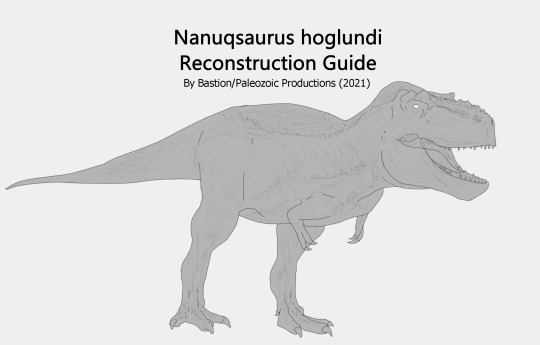
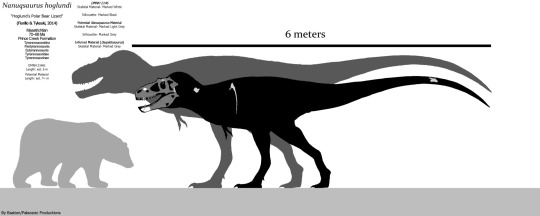
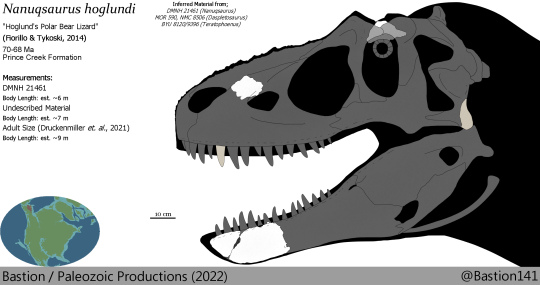
(The second image is more updated)
Welcome to another post of mine, and this time focusing on a semi-guide on reconstructing Nanuqsaurus, at least how I would. Hope everyone enjoys and finds this as a helpful guide!
DISCALIMER: Not everything here is set in stone, science and especially paleontology is an evolving field with changing and shifting information, not all things will remain fully accurate here due to potential new material, discoveries, papers, etc, and will be updated accordingly. Some content here can and will potentially enter scientifically speculative territory, even if there's a common consensus or evidence going for it. Until more information is fully published and confidence is raised, most "speculative" information will remain, though all are scientifically plausible based on our current and potential future understanding.
[Addressing "Linguistics" and Terms]
Few people as of recently have called this post "fantasy", "full of speculation", "mere guesswork and fiction", "a false guide", "not a reconstruction" (referring to the artwork), etc. You know who you are making these claims, it's not a lot of people but this section is simply going against these few-individual claims.
While some things here remain in the unknown and require some speculation, a lot of the speculation is founded off of scientific research and isn't "pure guesswork". A lot of fragmentary animals require extrapolation from other animals, such as with Gigantopithecus. Even though while much of it is not well known, it still qualifies as both a guide and things here as a reconstruction, even by definition, "a thing that has been rebuilt after being damaged or destroyed". As for guide, this post aims to elaborate and teach a reliable model of Nanuqsaurus as far as we know as of now, even if some of it has to be gathered from relatives. Just because something has be "guessed" (in a scientific sense) doesn't discredit the model from not being a reconstruction. Things here fall as completely valid for a reconstruction, even if the people making these claims lack the skills to put this into mind.
[Anatomy and Phylogenetics]

The first step I would suggest is finding a basis for the animal's anatomy. We don't have much of Nanuqsaurus to conclude a reliable outline for its skeleton and anatomical structure, with only a few bit of material from across the body yet to be published (a rib, few vertebrae) (https://www.youtube.com/watch?v=4tScqOtjVGE) and the rest being unpublished teeth (https://twitter.com/Paleo_Tykoski/status/1377984423824658432) and the Holotype (Fiorillo & Tykoski, 2014). The rest has to be assumed from using closely related Tyrannosaurs, which we'll get into next.
A common misconception with Nanuqsaurus is often making it an outright Albertosaurus or Gorgosaurus clone, with some occasionally lumping into either two, such as "A. hoglundi" or "G. hoglundi". This in fact is almost entirely wrong from the current consensus and what has been recovered quite recently. While Nanuqsaurus does lay inside of the Tyrannosauridae family, it is more derived, closer to Daspletosaurus and Tyrannosaurini (=Tyrannosaurus spp. to some), being phylogenetically outside of the clade that consists of both (Voris et al., 2020). A direct comparison of the available dentary material with other Tyrannosauridae members will give a similar result, especially in comparison to Daspletosaurus and juvenile individuals of Tyrannosaurus rex. Although placement isn't fully certain, some suggesting it being more basal with Teratophoneus, closer to Daspletosaurus, or closer to Tyrannosaurus. Though, the safest conclusion is through Voris et al., 2020.
With all of this in mind, it is safest to assume that Nanuqsaurus would possess Daspletosaurus-like anatomy and proportions, although potentially basal, with some traits likely to be similar to Teratophoneus (which would be less-derived features generally), with myself suggesting a heavier inspiration of the reconstruction using the former and some gathered traits from the former. The skeletal above gives a Daspletosaurus-inspired skull, with it being slightly more "thinner" to a slight degree. Although while most of this is subjective for how much of its anatomy should be what, a large majority should at least be closer to Daspletosaurus as with the associated skeletal.
[Ontogeny]

(Tyrannosaurus Ontogeny chart by Franoys)
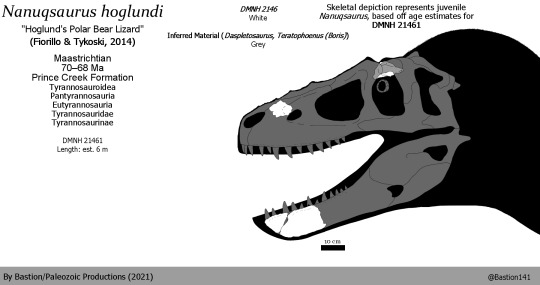
For ontogeny, mainly it boils down to looking at other Tyrannosaurs. Other tyrannosaurids tend to have more gracile and swift anatomy for younger individuals. If you were to reconstruct the holotype or something of young age, following the patterns that other Tyrannosaur ontogeny has would be a smart move. Juveniles being more like juvenile Tyrannosaurus (and other Tyrannosaurs overall), being built for speed. Adults as mentioned above would have more Daspletosaurine anatomy (refer to skeletal anatomy).
The jaw fragment we do have in store has some similarity with juvenile Tyrannosaurus rex and Tarbosaurus bataar. It mainly possesses similarity in shape, which isn't at all hard to do, although it is narrower. Since the holotype is confirmed to be a younger individual (at least from a juvenile), it is likely that the ontogeny follows the same patterns all Tyrannosaurids do.
Nanuqsaurus holotype, DMNH 21461, was suggested to be a younger individual (Druckenmiller et al., 2021). It would be safe to assume when reconstructed the holotype itself rather than an adult, a more juvenile look would be needed. Most of the anatomy in the skeletal above is taken from the Boris specimen which belongs to Teratophoneus. Which stage of juvenile exactly is up to debate but middle-aged juvenile would be plausible.
[Size]
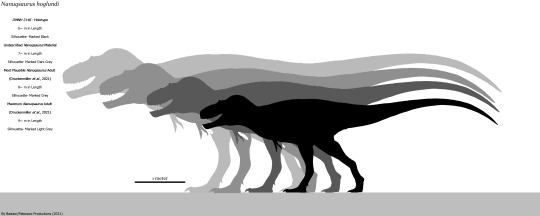
(Anatomy to each size is not modified, holotype would likely have juvenile features, 9 m length is maximum based off reasonable hypothesis, 8~ m length is most plausible)
Nanuqsaurus ironically against its initial reputation isn't exactly as small as thought. The previously linked video above dives into the unpublished material being considerably larger than the holotype, being comparable to a large-ish juvenile Tarbosaurus at approximately 7 meters long as a rough estimate. For an additional confirmation, extra potential larger material is rumored and mentioned and a considerably larger size for the animal compared to the holotype is in place (Druckenmiller et al., 2021). Recent information according to the paper suggests the aforementioned size increase with the holotype being an immature specimen (of juvenile or very young sub-adult specimen) and the adults generally being "[Rather, adult-sized teeth and isolated postcranial elements] ...[closer to a] adult body size more closely comparable to other North American tyrannosaurid taxa, such as Albertosaurus sarcophagus." (Druckenmiller et al., 2021). This would suggest a size around 7 to 9 meters long, which previous rumors including the linked video from before also suggest. This contradicts the "dwarf tyrant" that Nanuqsaurus was originally viewed as from the holotype with it originally being 5 to 6 meters in length. To quote the paper to help reinforce this statement;
"UAMES 17610 is an isolated tyrannosaurid (c.f. Nanuqsaurus hoglundi) premaxillary tooth crown (height = 8.4 mm) from the Prince Creek Formation (Kikak-Tegoseak Quarry; Figures S5C and S5D). It is one of the smallest known North American tyrannosaurid teeth. The tooth is ∼32% the crown height of UAMES 29370, the largest, presumably adult-sized premaxillary tooth known from the Prince Creek Formation (crown height = 26.5 mm). We compared the Alaskan teeth to MPC-D 107/7, an articulated skull and partial skeleton of a juvenile Tarbosaurus bataar from the Nemegt Formation of Mongolia. Premaxillary crown height of UAMES 17610 is 73% that of MPC-D 107/7 (right, second premaxillary tooth = 11.5 mm82
). Premaxillary crown height in MPC-D 107/7 is 3.9% skull length ( = 290 mm). Applying the same tooth scaling factor, we estimate the skull length of UAMES 17610 at ∼21 cm. MPC-D 107/7 is estimated to have been ∼2.5 years old at death;82
plotting at ∼73% the size of MPC-D 107/7 onto the curve of Erickson et al.83
suggests UAMES 17610 was from an individual at or within the first year of life, termed young-of-the-year.23
TMP 1996.005.011 has nearly the exact same crown height as UAMES 17610 and its developmental status is similarly interpreted as being likely a nestling or young juvenile.We also compared UAMES 17610 to TMP 1996.005.011, a very small premaxillary tooth (crown height = 8.5 mm) referred to Albertosaurus sarcophagus from the Horseshoe Canyon Formation of Alberta, Canada.36"
[Feather Integument]
Integument in the current image of paleontology online is currently one of the most heated and controversial topics regarding paleontology in recent years, especially on Tyrannosauridae members. Nanuqsaurus gets a lot of representation in the integument department in popular culture due to its genera name (Polar Bear Lizard) associated with the arctic cold. Prince Creek, the formation and locality Nanuqsaurus is found in is situated in Alaska very far north geologically. Even though Prince Creek is associated with being in the arctic, it wasn't polar-levels cold, although it reached 10 to 12 °C on average during summer months, with -2 to 4 °C average during the winter, being as low as -10°C, (Druckenmiller et al., 2021) (Flaig et al., 2013). In comparison, Hell Creek is on average a ~7-11 °C in temperature (Wilson et al., 2014)(?), with Nemegt being somewhere around although slightly colder, exact temperature uncertain from my end (Owocki et al. 2019). Often the source of heavy integument for Nanuqsaurus is reasoned due to the apparent "polar temperatures", which is often debatable with how much, especially when you look at other similar formations with Tyrannosaurines.
With the likelihood of extremely derived Tyrannosaurines, like Tyrannosaurus rex, it is safe to assume that Nanuqsaurus, being more basal and not too far from Tyrannosaurus rex has a similar integument pattern based on what we have regarding skin impressions in Tyrannosaurines (Bell et al., 2017). The feathering would most likely be restricted to the back of the neck and along the back to at most the tail, with a maximum extent of the middle of the sides of the torso (Bell et al., 2017). My speculation and recommendation, and what seems most plausible given the evidence, would be having the feathers extending down partially to the 1/4 waypoint to the abdomen chest region, although there's a ton of speculation regarding how far it can go down. I suggest this purely because of the similar (although occasionally very cold) climate Prince Creek has to other well-known Cretaceous formations which would at least suggest not much of a drastic change to the integument of the animal in most cases, not at all needing an extreme coat of feathers extending across the majority of the body but more to the back and side of the animal. Such feathering would assist in keeping Nanuqsaurus warm during extreme climates in places that would best require it, so a potential heavy back-coat of feathering would assist in this. Thicker skin would also help for warmth in addition to feathering.
To potentially back up the claim that Nanuqsaurus likely had these primitive feathers, an ongoing reconstruction sculpt of Nanuqsaurus is currently being made, which on their page describes “Northern Tyrant King” represents new ongoing discoveries in multiple locations of Alaska concerning this ancient apex predator including size, primitive feathers, sexual dimorphism as well as other soon to be announced aspects featured within the canvas. These new discoveries will be shared once the scientific announcements are made public and papers published.", from https://havensstudio.online/nanuqsaurus-sculpture. Although not concrete evidence, it hints at the potential existence of direct evidence for feathering (and other aspects of the animal).
[Keratin]
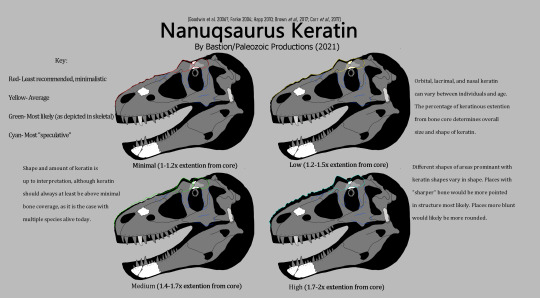
Keratin isn't as controversial of a topic but is still worth discussing due to it being a mild topic. Most animals with bone cores for keratin often have an extensive amount of keratin extending from the core, being more than what is implied skeletally. This is true for many dinosaurs, such as Triceratops horns (Goodwin et al. 2006?, Farke 2004; Happ 2010) and Ankylosaurids (Brown et al., 2017). These bone cores and keratin extensions also exist in multiple other tyrannosaurs, being described for Daspletosaurus (Carr et al., 2017). Tyrannosaurus rex also has very similar structures, with the same bosses and snout-keratin found on the face on its lacrimals and postorbital bones. Keratin shape and extension level is usually what is debated. Some people often for Tyrannosaurus rex will go for reduced bosses, blunt in shape or expressed bosses sharper in shape, good example with Digital Duck's Tyrannosaurus reconstruction. This though varies from animal to animal, with creatures like Daspletosaurus having much more shaper bosses suggesting a 100% certainty of expressed sharp "brow horns". How far one can go can depend on each person and speculated purpose for them, although most animals tend to exaggerate keratin so a more pointed and exaggerated shape is more likely. What this might've functioned for is entirely speculative. "Snout keratin" is the exact same as above, with a potential mix of cornified sheathes and keratin, and the same can be said for keratin surrounding the orbital above. Feel free to go speculative with shape, although I suggest with potential likelihood as above is most plausible.
Facial integument itself other than lips is self-explanatory and not much to cover, and claw keratin on the hands and toes generally applies the same, universal with all other Tyrannosauridae species. Facial integument would consist of the same or at least similar arrangement from Carr et al., 2017, with large protective ornamental scales on the side of the premaxilla and armor-like skin on the sides on the top of the snout region.
[Lips]
Lips, along with feathering, is one of the most debated subjects in recent paleontology. You often see people on the internet consistently arguing for or against this on online paleontology circles. And while there is a lack of official scientific publications regarding archosaurian lips, we can assume from evidence and comparisons with other animals.
Often, it is argued that formina count, maxillary rugosity, or simple phylogenetics goes against lips for Nanuqsaurus. Though this is untrue, since other and more reliable comparisons can be made against these claims. Rugosity doesn't contribute to liplessness, as seen with Rhinoceros Iguanas (Cyclura cornuta) and Pacman Frogs (Ceratophrys spp), and a variety of other animals. These creatures often have high rugosity and formina count in their maxillary and general skull region, although they in life aren't lipless. If many arguments for the lipless model were true, many of these animals would be lipless, including fossil Pacman Frogs which tend to be much more rugose along with many other fossil taxa such as Eryops. Applying this logic to other animals with a similar formina count/rugosity would lead to them also being lipless, which isn't true. Crocodilians themselves are extremely different, which can be better explained in Mark Witton's post about the same topic, which I suggest reading than strictly this. Although to generally summarize, Crocodilians feature a completely different rugosity pattern across their skull that isn't at all comparable to Tyrannosauridae or generally dinosaurs. Dinosaurs have more squamate-like rugosity in the maxillary and dentary regions rather than being closer to crocodilians. Crocodilians feature highly patterned skull texture which as they approach adulthood gets strengthened. Not only that but Crocodiles to feature a very different arrangement of teeth compared to theropods, interlocking rather than fully overlapping the mandible.
Phylogenetics is often argued purely because birds don't have lips and Crocodiles don't have lips, with them being archosaurs. Dinosaurs are obviously archosaurs, so they lack lips too... right? Not really. Aves themselves have beaks in place of normal snouts, lined with keratin and lacking teeth altogether, the need for lips is mute here. Lips aim to protect the teeth and without teeth there would be no need for such a thing, and birds generally being very derived. Crocodilians are extremely derived as well with a unique niche and adapted anatomy for a different lifestyle compared to Tyrannosaurines (and other dinosaurs). It's not fair to use these creatures in any comparison since they're generally not at all comparable, so it would be better to use other reptiles as reference. Squamates generally have the best references for lips in both structure and arguments. They're comparatively the "least" derived and again have more comparable rugosity compared to Crocodilians (even though rugosity really has no bearing on liplessness).
The lack of lips would not only leave teeth vulnerable and exposed to the outside world but would leave the creature at a disadvantage. Enamel requires constant moisture. Lips provide that by simply existing and providing the needed moisture constantly while also functioning as protection. Without lips, moisture would not be supplied and would eventually lead to the enamel drying out and decaying (which obviously is a bad thing). This is a well known fact.
Lips also are a basal feature to all of tetrapoda and fishes. Practically every animal has them in modern day besides a very few select ones. The lack of lips is a rare trait in the animal kingdom, excluding birds. Besides Crocodilians, all modern reptiles have it. All mammals have it. All amphibians have it. Majority of fishes have it. The process to loose lips seems to of occurred in such few groups that the entirety of Dinosauria losing them would be such a mindless and ignorant stretch from lack of proper reasoning and such of an oversimplification that logically it would make no absolute sense. Lips are a preferred trait universal to the animal kingdom.
This is explained better in Mark Witton's post. All of this though will later be updated when the publications for lips come out.
With all of this in mind, it's best to go with Nanuqsaurus having lips. Due to them being reptiles, I 100% suggest non-derived lips such as non-varanid reptile lips, which are stiff in structure which creates a perfect seal. Creatures such as Tegus work really well.
Other topics regarding mouth tissue, such as palate anatomy, are also important to consider but much more straightforward. It's best to use varanid palates as a reference for tissue, since they themselves are comparable to the majority of theropods, such as Allosaurus.
[Paleo-Reconstruction Tropes and Misconceptions]

Nanuqsaurus is often one of those dinosaurs that is only ever depicted in a few specific ways with little amounts of actual good reconstructions outside of one trope. We previously covered in topic of phylogenetics that Nanuqsaurus is closely related to Daspletosaurus and the Tyrannosaurini tribe than any other group. A lot of hypothesis reconstructions back in the day used to say otherwise. The first Nanuqsaurus material while not yet named was found in 2000 as Tyrannosaurid teeth (Fiorillo et al., 2000). Later around 2006, actual material of Nanuqsaurus would be found but would be categorized as Gorgosaurus or Albertosaurus. Multiple interpretations of Nanuqsaurus wouldn’t actually be called it but instead any of the two Albertosaurines. The actual naming of Nanuqsaurus wouldn't happen until 2014 which would separate it from Albertosaurines but on occasion would still be placed quite close to them.
A common misconception is that Nanuqsaurus is an Albertosaurine and occasionally is lumped into one of the two taxa by genera level or occasionally species. I already covered this earlier in the classification chapter and recovered that Nanuqsaurus is most likely outside of Daspletosaurus and Tyrannosaurini. Both of these wouldn't make it look like a Gorgosaurus despite what many would say.
Another thing to cover is more a trope than a misconception but is somewhat still flawed. Many Nanuqsaurus reconstructions in popular media tend to give a massive density and quantity of feathers which are often white. This goes for most science articles going over Nanuqsaurus, popular reconstructions in paleoart, Youtube videos, toy figurines, and even the recent “Dinosauria” short “Our Frozen Past”. A lot of this comes from two things, it’s name (Polar Bear Lizard) and many people thinking what Prince Creek was like in climate. Most depictions of Prince Creek tends to put it in a very polar tundra climate with ice-age type snow levels. As previously mentioned this is entirely wrong, and while Prince Creek did get snow, it would no where be as prolonged as it is often depicted. Nanuqsaurus likely did live in more closed environments like forested regions or places with lots of foliage coverage so would be more adapted in coloration to those than blending in the snow. Refer to coloration for more information.
As for the feather quantity, this was already covered in the section regarding body feathering. Though to generally recap, such high amounts of feathers wouldn’t be needed for the climate it lived in and at most a coat of feathers on the back and neck would do well mixed with thicker skin. In no way would Nanuqsaurus need that amount of coverage in an actual accurate depiction of Prince Creek.
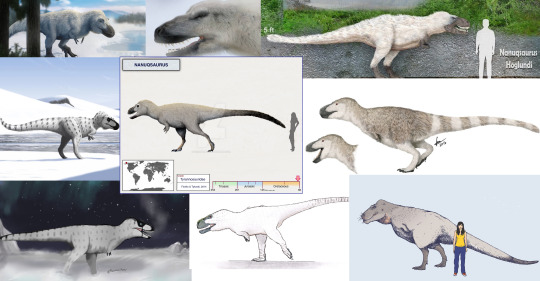
Multiple examples of the Polar Bear lizard viewpoint. No mocking or poor behavior is intended upon the art and artists (as they are all great). All art belongs to their respective owners. (From left to right: Kepyle, Video from Henry the PaleoGuy, SameerPrehistorica, Nathan Rodgers, cisiopurple, Gabriel N. U?, Redwood Raptor,Federico benzan, C. M. Koseman)
[Conclusion]
This is my resolution for this guide to reconstructing Nanuqsaurus, I aim to update this post as time goes on with a better understanding and evolution of information on this animal as time progresses. I hope everyone found this informative and helpful for anyone reconstructing this relatively obscure creature.
Though, for those who want to keep interested in this Tyrannosaur, I mentioned before a sculpt being made of Nanuqsaurus, which I'll link again for those who want to keep updated (https://havensstudio.online/nanuqsaurus-sculpture). I will attempt to find other Nanuqsaurus-related projects to link here, feel free to share some. And before finally concluding, I will state that whenever more of this rumored Nanuqsaurus material is released, which should hopefully be pretty soon, I'll redo a skeletal for it with the new material. Though, hope everyone found this very interesting and helpful, so see you around!
Updates-
Update 1: Revised lip arguments
Update 2 (25/6/21): Revised climate, feathers, and size.
Update 3 (09/8/21): Added Ontogeny and fixed outline.
Update 4 (3/10/21): Added ontogeny paragraph.
Update 5 (11/10/21): Added Frontpage Image
Update 6 (13/10/21): Added Misconceptions and Tropes + Nanuqsaurus through the years + Updated Size Graph + Added Franoys' ontogeny chart (placeholder) + Keratin Chart
Update 7 (24/10/21): Added Juvenile skeletal and information
Update 8 (07/11/21): Lip Argument revision
-Thanks for reading this! Bastion.
68 notes
·
View notes
Text
Experimenting with the tagging system
Tried to get a little more specific with tags. Because I'm the type of artist which will spend time looking at the genuses in Tyrannosauroidae to get an idea of appearance.
For example, I reblog a Tyrannosaurus rex reconstruction. It will be tagged:
#tyrannosaurus rex #tyrannosaurus #tyrannosaurinae #tyrannosaurini #tyrannosauridae #theropoda #theropod #saurischia #dinosaur
+ any appropriate book-keeping tags, so #accurate and #good design for example.
It's a little bulky, but some of the tags will be particularly useful when searching, like if you're just in the mood to look at chasmosaurines.
#maybe it'll help me get better with remembering phylogenetic placing for some animals too lmfao#mod fraizer
1 note
·
View note
Photo

25 Dinocember
Fluffy santa
#trex#t-rex#tyrannosaurus#tyrannosaur rex#tyrannosaurini#tyrannosauroid#feathers#feathered dinosaurs#dinosaur#dinosaurs#dino#santa#paleontology#paleoart#dinocember#snow#Own Art#artists on tumblr#digital art
15 notes
·
View notes
Text
Re-analysis of a dataset refutes claims of anagenesis within Tyrannosaurus-line tyrannosaurines (Theropoda, Tyrannosauridae)
Published 28th November 2023
Phylogenetic reanalysis of Daspletosaurus wilsoni reveals a cladogenetic Tyrannosaurinae composed of four morphologically and biogeographically distinct clades that are formally defined and diagnosed (Teratophoneini clade and Tyrannosaurini).
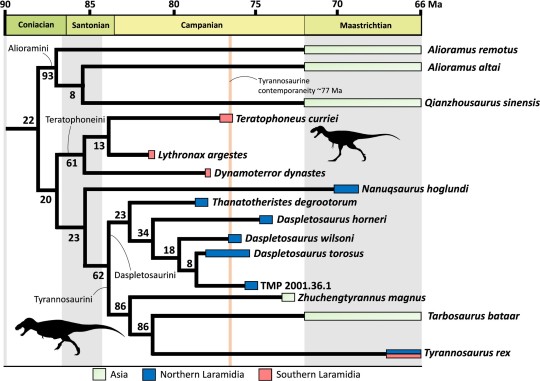
Cladistic analyses strict consensus phylogeny of Tyrannosaurinae

Stratigraphic distribution of the species of Daspletosaurus
Source:
3 notes
·
View notes
Photo

Last week on February 28, as long as I read the paleo paper about new species of Tyrannosaurus, I’m honestly have mixed reaction from regard against the paper. At first, I surprised about two new species like Tyrannosaurus imperator (Tyrant lizard emperor) and another Tyrannosaurus regina (Tyrant lizard queen) are just splitting up into three. While others are completely insane and even disagree with the published paper by the name of Gregory S. Paul, along with two other people W. Scott Persons IV and Jay Van Raalte. So hope of you enjoy this. #tyrannosaurus #tyrannosaurusrex #tyrannosaurusimperator #tyrannosaurusregina #tyrannosauridae #tyrannosaurini #tyrannosaurinae #tyrannosaurine #theropoda #sketchbookapp #artistsoninstagram #myart https://www.instagram.com/p/CaxOZ-ELEWe/?utm_medium=tumblr
#tyrannosaurus#tyrannosaurusrex#tyrannosaurusimperator#tyrannosaurusregina#tyrannosauridae#tyrannosaurini#tyrannosaurinae#tyrannosaurine#theropoda#sketchbookapp#artistsoninstagram#myart
1 note
·
View note
Photo
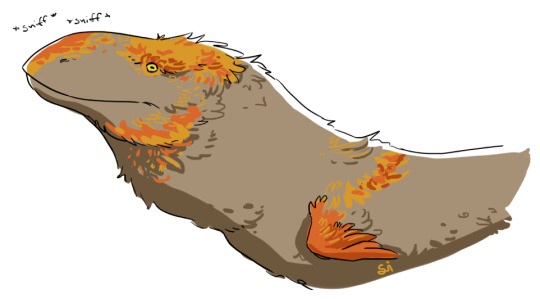
15 Dinocember
Tyrannusaurus Rex, the big and mighty murder chicken
#dinocember#tyrannosaurus#tyrannosaur rex#tyrannosaurini#tyrannosauroid#fluffy murder machine#feathers#feathered dinosaurs#modern dinosaur#derpy#dinosaur#dinosaurs#dino#Dinos#trex#digital art#Own Art#artists on tumblr#paleoart#paleontology
21 notes
·
View notes